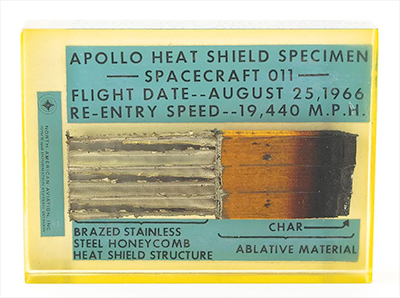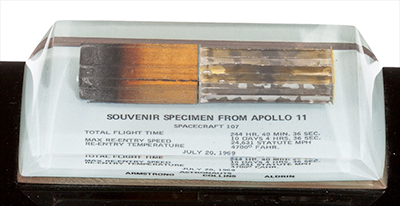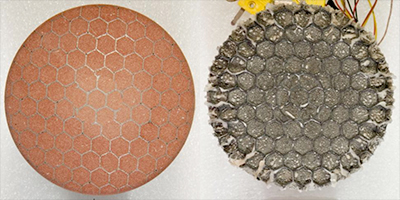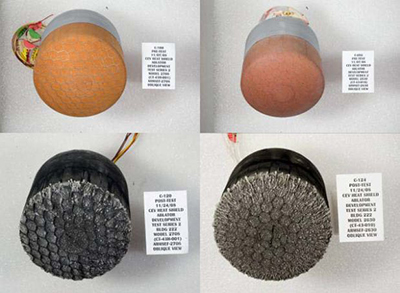|
Author
|
Topic: Telling lunar and Earth orbit heatshields apart
|
MartinAir
Member Posts: 237
From:
Registered: Oct 2020
|
 posted 10-31-2022 08:47 PM
posted 10-31-2022 08:47 PM
   
Is there a way to tell lunar and Earth orbit flown heat shields apart? For example, I'm not able to spot the difference between these AS-202 and Apollo 11 samples.  
|
oly
Member Posts: 1428
From: Perth, Western Australia
Registered: Apr 2015
|
 posted 11-01-2022 05:06 AM
posted 11-01-2022 05:06 AM
   
Both are Earth atmosphere heat shields designed to protect a spacecraft from the heat generated during atmospheric re-entry. There is no requirement for an ablative lunar heat shield because the Moon has no discernible atmosphere.
|
Robert Pearlman
Editor Posts: 49548
From: Houston, TX
Registered: Nov 1999
|
 posted 11-01-2022 08:13 AM
posted 11-01-2022 08:13 AM
   
I think the question was more in regards to the difference in lunar return and Earth orbit return speeds and if that resulted in more or less charring such that one could tell by sight that a given heat shield sample had flown to the moon. |
David Carey
Member Posts: 967
From:
Registered: Mar 2009
|
 posted 11-01-2022 10:03 AM
posted 11-01-2022 10:03 AM
   
For any given re-entry, wasn’t there significant variation in charring depth depending on position within the heat shield? (i.e. differing heat load on leading edge vs elsewhere)Scott (spaceaholic) also outlined a related difference in initial heat shield thickness depending on location in this earlier cS thread. |
MartinAir
Member Posts: 237
From:
Registered: Oct 2020
|
 posted 11-01-2022 12:12 PM
posted 11-01-2022 12:12 PM
   
Thank you for replies. There are also heat shield samples that were not assigned to a specific mission and was wondering whether it is possible to at least guesstimate the Moon/Earth orbit flight status. |
Spacepsycho
Member Posts: 887
From: Huntington Beach, Calif.
Registered: Aug 2004
|
 posted 11-01-2022 03:03 PM
posted 11-01-2022 03:03 PM
   
The LEO missions of 4, 5, 6, 7, 9, Skylab and ASTP, experienced less ablator char reentering the atmosphere at 17,500mph vs the spacecraft returning from the moon at 25,000mph. The char depth of any AVCO heatshield is very difficult if not impossible to replicate on earth. I have a large collection of flown Apollo heatshield pieces from every mission and there are small differences between the LEO vs lunar CM heatshields. The CM heatshields were thinned out on later missions to reduce weight, after earlier missions proved how well the ablator material performed. |
SpaceAholic
Member Posts: 5182
From: Sierra Vista, Arizona
Registered: Nov 1999
|
 posted 11-01-2022 04:16 PM
posted 11-01-2022 04:16 PM
   
quote:
Originally posted by Spacepsycho:
The LEO missions of 4, 5, 6...
Apollo 4 achieved lunar mission profile reentry velocity; Apollo 6 just below the target.
|
Robert Pearlman
Editor Posts: 49548
From: Houston, TX
Registered: Nov 1999
|
 posted 11-01-2022 04:59 PM
posted 11-01-2022 04:59 PM
   
quote:
Originally posted by Spacepsycho:
...if not impossible to replicate on earth.
While by no means simple, Avco's Applied Technology Division was able to simulate the complete profile of a reentry from a lunar mission "using electric arc devices ranging from 30 kw. models up to 10 megawatt giant (10 million watts)."I don't have a photo handy but I do recall seeing on display Avcoat samples, one removed from a lunar Apollo mission and one from an arc jet ground test and they were indistinguishable from one another. |
SpaceAholic
Member Posts: 5182
From: Sierra Vista, Arizona
Registered: Nov 1999
|
 posted 11-01-2022 10:43 PM
posted 11-01-2022 10:43 PM
   
Dont know of any Apollo arc jet test models that utilized AVCOAT in the configuration as applied on the CM (i.e gunned into nylon honeycomb cells); the Apollo arc jet specimens I have encountered were molded and easily distinguishable from spacecraft removed ablator cores. Orion program arc jet testing evaluated gunned samples. |
Robert Pearlman
Editor Posts: 49548
From: Houston, TX
Registered: Nov 1999
|
 posted 11-01-2022 11:30 PM
posted 11-01-2022 11:30 PM
   
This is not the display I referenced earlier (it more closely resembled the samples at the top of this thread), but the result of a search. NASA described this as "Before and after Avcoat arc jet models" and "Consists of a honeycomb filled with an ablative mixture" (source). |
SpaceAholic
Member Posts: 5182
From: Sierra Vista, Arizona
Registered: Nov 1999
|
 posted 11-01-2022 11:35 PM
posted 11-01-2022 11:35 PM
   
Pretty certain the image is of post Apollo test samples (circa Orion Program timeframe). |
Robert Pearlman
Editor Posts: 49548
From: Houston, TX
Registered: Nov 1999
|
 posted 11-01-2022 11:38 PM
posted 11-01-2022 11:38 PM
   
Yes, it is. Here is another photo from the same series: On the left is the heritage (Apollo) Avocoat for the Apollo Command Module. On the right is the Advanced Development Project (ADP) Avcoat for the Orion Command Module.  |
MartinAir
Member Posts: 237
From:
Registered: Oct 2020
|
 posted 11-02-2022 01:26 PM
posted 11-02-2022 01:26 PM
   
Are the maximum entry surface temperatures for the AS-202 and Apollo 6 in the AVCO press release correct? They seem a bit low given the reentry speeds. |
MartinAir
Member Posts: 237
From:
Registered: Oct 2020
|
 posted 11-26-2022 11:42 AM
posted 11-26-2022 11:42 AM
   
What were the differences between Apollo Block I and Block II heat shield? |















